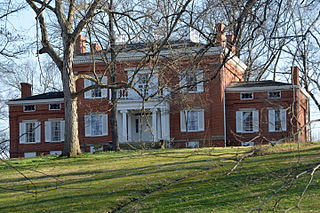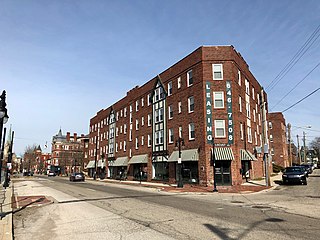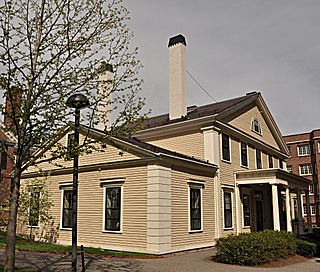
Warren County is a county located in the southwestern part of the U.S. state of Ohio. As of the 2020 census, the population was 242,337. Its county seat is Lebanon and largest city is Mason. The county is one of Ohio's most affluent, with the highest median income of the state's 88 counties. The county was established on May 1, 1803, from Hamilton County; it is named for Dr. Joseph Warren, a hero of the Revolution who sent Paul Revere and the overlooked William Dawes on their famous rides and who died at the Battle of Bunker Hill. Warren County is part of the Cincinnati, OH-KY-IN Metropolitan Statistical Area.

Lebanon is a city in and the county seat of Warren County, Ohio, United States. The population was 20,841 at the 2020 census. It is part of the Cincinnati metropolitan area.

Union Township is one of the eleven townships of Warren County, Ohio, United States, located in the central part of the county. It was established January 3, 1815 and named Union as it was formed from parts of Deerfield and Turtlecreek Townships. The population was 6,251 as of the 2020 census.

Hamilton Township is one of the eleven townships of Warren County, Ohio, United States. It is located in the south central portion of the county. The population was 30,587 at the 2020 census.

The Golden Lamb Inn is the oldest hotel in Ohio, having been established in the Warren County seat of Lebanon in 1803. The present four-story structure is built around the 1815 rebuilding of the inn, maintaining its colonial architecture. It is known as the Golden Lamb because that image appeared on its signboard for the benefit of the illiterate. At various times it has been known as the Ownly Hotel, the Bradley House, the Lebanon House, and the Stubbs House.

Kings Mills is a census-designated place in the southwestern corner of Deerfield Township, Warren County, Ohio, United States, on the western shore of the Little Miami River. The population was 1,336 at the 2020 census.

Glendower, now known as Glendower Historic Mansion and Arboretum, is a historic Greek Revival style house located at 105 Cincinnati Avenue, U.S. Route 42, Cincinnati Avenue, in Lebanon, Ohio. It was built in 1836 by Amos Bennett for John Milton Williams, a Lebanon merchant, and named for Owain Glyndŵr. It has been called "one of the finest examples of Residential Greek Revival architecture style in the Midwest."

South Park is a 24-block, 150-acre area of more than 780 structures primarily dating from the 1880s to the early twentieth century. It is located south of downtown Dayton, Ohio, just north of the University of Dayton campus and Woodland Cemetery, and east of Miami Valley Hospital. Mainly residential in character, South Park is significant because of the variety of its architecture, which includes vernacular, cottage, and high style examples, and because of its association with John H. Patterson, founder of the National Cash Register Company.

The Old Jeffersonville Historic District is located in Jeffersonville, Indiana, United States. It marks the original boundaries of Jeffersonville, and is the heart of modern-day downtown Jeffersonville. It was placed on the National Register of Historic Places in 1983. The area is roughly bounded by Court Avenue at the North, Graham Street on the east, the Ohio River at the south, and Interstate 65 at the west. In total, the district has 203 acres (0.8 km2), 500 buildings, 6 structures, and 11 objects. Several banks are located in the historic buildings in the district. The now defunct Steamboat Days Festival, held on the second weekend in September, used to be held on Spring Street and the waterfront. Jeffersonville's largest fire wiped out a block in the historic district on January 11, 2004 which destroyed the original Horner's Novelty store.

The Oregon Historic District is a neighborhood in Dayton, Ohio. The Oregon District includes one of the earliest surviving combinations of commercial and residential architecture in Dayton. Examples of Dayton's architectural history from 1820 to 1915 line the brick streets and lanes in this 12 square block area. Styles range from Federal to Queen Anne. Excellent examples of late Victorian commercial and residential architecture illustrate both the entrepreneurial success and the increasing affluence of many Oregon merchants and residents. The district is populated with art galleries, specialty shops, pubs, nightclubs, and coffee houses.

East Walnut Hills is a neighborhood on the Southeast side of Cincinnati, Ohio. The population was 4,103 at the 2020 census.

Westwood United Methodist Church is a historic Methodist church in Cincinnati, Ohio, United States. Constructed in 1896 for an established congregation, it has been named a historic site.

Sidney Rose Badgley was a prominent start-of-the-20th-century Canadian-born architect. He was active throughout the United States and Canada, with a significant body of work in Cleveland.

The Beck-Warren House, also known as the Warren House, is a historic house located in Cambridge, Massachusetts. Now on the campus of Harvard University, this large Greek Revival wood-frame house was built in 1833 for Professor Charles Beck, and was later purchased and adapted by the physically disabled Henry Clarke Warren, a Sanskrit scholar. Since 1899 it has belonged to Harvard University, for whom it presently houses offices. The house was listed on the National Register of Historic Places in 1996.

The Warren Sweetser House is a historic house at 90 Franklin Street in Stoneham, Massachusetts. It is one of the finest Greek Revival houses in Stoneham, recognized as much for its elaborate interior detailing as it is for its exterior features. Originally located at 434 Main Street, it was moved to its present location in 2003 after being threatened with demolition. The house was found to be eligible for listing on the National Register of Historic Places in 1984, but was not listed due to owner objection. In 1990 it was listed as a contributing resource to the Central Square Historic District at its old location. It was listed on its own at its new location in 2005.
Many Neighborhoods of Toledo, Ohio are of historic interest.

The Sheldon Inn was a two-story apartment building located at 44134 Michigan Avenue, in Sheldon Corners in Canton Township, Michigan. It was built in 1825, and previously used as a single-family home and a travelers' inn. It was listed on the National Register of Historic Places in 2000. It was demolished in 2021.
Cincinnati Township is a paper township and former civil township in south-central Hamilton County, Ohio. Originally one of Ohio's largest townships by area at its inception in 1791, it was abolished in 1834 when the City of Cincinnati became coextensive with it through annexation. Since then, it has remained solely as a paper township.






























